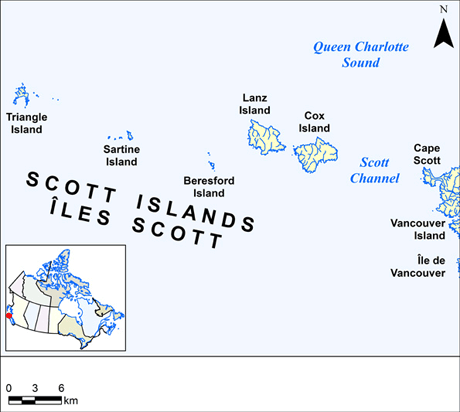
News/Reports
The Scott Islands: A Proposed Marine National Wildlife Area
Draft Regulatory Strategy (in revision to publish the final version)
Accessed 20/02/14 : http://www.ec.gc.ca/ap-pa/?lang=En&n=90605DDB-1
- Introduction
- Why establish a National Wildlife Area around the Scott Islands?
- Map of the Area
- Conservation Goals
- Contact Information
Introduction
There are marine areas of Canada’s oceans that are globally and nationally important to the survival of many species of seabirds. The federal government has enacted legislation to conserve and protect these marine areas. The Canada Wildlife Act allows important marine wildlife habitats, particularly for migratory birds and endangered species, to be set aside as National Wildlife Areas for the purposes of wildlife conservation, research and interpretation.
Why establish a National Wildlife Area around the Scott Islands?
 The Scott Islands1 supports the highest concentration of breeding seabirds in Canada’s Pacific ocean. About 40% of the seabirds that breed in British Columbia nest there. That includes 9 of every 10 Tufted Puffins in Canada and approximately half of all Cassin’s Auklets in the world. The Scott Islands marine area2 is already an internationally recognized Important Bird Area and is one of the single most ecologically vital locations in all of the Northwest Pacific Ocean ecosystem.
The Scott Islands1 supports the highest concentration of breeding seabirds in Canada’s Pacific ocean. About 40% of the seabirds that breed in British Columbia nest there. That includes 9 of every 10 Tufted Puffins in Canada and approximately half of all Cassin’s Auklets in the world. The Scott Islands marine area2 is already an internationally recognized Important Bird Area and is one of the single most ecologically vital locations in all of the Northwest Pacific Ocean ecosystem.
 Five islands make up the Scott Islands archipelago. Lanz and Cox Islands are closest to Vancouver Island shores and were designated as a Class “A” Provincial Park in 1995. The outer three islands of Sartine, Beresford, and Triangle (Anne Vallée) became provincial Ecological Reserves in 1971. The seabirds that nest on the Scott Islands need a healthy ocean, rich in their primary food sources of fish and zooplankton. Birds may travel distances of up to 85 to 120 kilometres from the Scott Islands to feed in the open ocean waters. Over 15 years of shipboard bird observation surveys of this marine region have shown widespread and extensive use by migratory seabirds. In addition, telemetry data confirmed important areas where breeding birds forage to feed themselves and their young.
Five islands make up the Scott Islands archipelago. Lanz and Cox Islands are closest to Vancouver Island shores and were designated as a Class “A” Provincial Park in 1995. The outer three islands of Sartine, Beresford, and Triangle (Anne Vallée) became provincial Ecological Reserves in 1971. The seabirds that nest on the Scott Islands need a healthy ocean, rich in their primary food sources of fish and zooplankton. Birds may travel distances of up to 85 to 120 kilometres from the Scott Islands to feed in the open ocean waters. Over 15 years of shipboard bird observation surveys of this marine region have shown widespread and extensive use by migratory seabirds. In addition, telemetry data confirmed important areas where breeding birds forage to feed themselves and their young.
Map of the Scott Islands
Conservation Goals
The draft conservation goals for the candidate Scott Islands National Wildlife Area are:
- The natural habitats, ecosystem linkages, and marine resources that support seabird populations nesting on the Scott Islands are protected and conserved.
- The risk of adverse effects on the breeding productivity and survival of seabirds resulting from human activities is mitigated in keeping with the conservation and protection objectives.
- The marine National Wildlife Area is managed in a manner that recognizes the authorities for management of human activities in the marine environment and takes into account the socio-economic and cultural values sustained by the marine ecosystem.
- Understanding of the marine ecosystem and socio-economic and cultural values informs management of the marine National Wildlife Area.
Contact Information
For more information on the Scott Islands candidate National Wildlife Area, contact the Environment Canada regional office:
Environment Canada – Pacific and Yukon Region
Canadian Wildlife Service
Protected Areas & Stewardship
5421 Robertson Road
Delta, BC
V4K 3N2
Toll Free: 1-800-668-6767 (in Canada only)
Email: enviroinfo@ec.gc.ca
1 A short video of the Scott Islands can be viewed on the Scott Islands Survey`s Channel site.
2 As part of the overall Health of the Oceans Initiatives, the Government of Canada has made a commitment to designate a National Wildlife Area to protect marine foraging habitats of the seabirds that nest on the Scott Islands.

